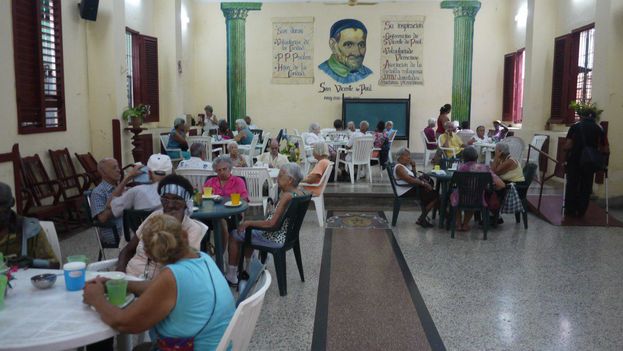DINNING HALL FOR THE POOR AT THE CHURCH ‘LA MILAGROSA’ IN HAVANA CAN NOT DO ENOUGH.
It arrives near noon with a metallic glass and a plastic jabita. Roberto is one of the many elderly who eat lunch in the parish of La Milagrosa, in the Havana neighborhood of Santos Suárez. The ration he receives at breakfast, lunch and snack is the main sustenance of this 78-year-old retiree who receives a pension of 220 CUP per month, less than ten dollars.
The place, run by the Catholic Church, is packed full of food, and the nuns who manage the kitchen ensure that they are barely able to help those in need. The humanitarian service continues, although its main inspirer, the priest Jesús María Lusarreta, passed away last July 14 at the age of 80 years.
Since he settled in the island in the early 1990s, the parish priest, born in 1937 in the Navarre town of Lumbier (Spain), promoted several programs to help the elderly and disabled, as well as providing a space for children and young people With Down syndrome. However, the impoverishment of the surrounding neighborhoods was tightening the temple’s ability to help all who knocked on its doorstep.
Lusarreta also established a system of home help to bring food to people who could not get to the parish and not infrequently asked for money from his own family in Spain to defray the expenses of a maintenance that has not stopped growing in recent years .
According to data from the Provincial Directorate of Assistance and Social Security in Havana, 335,178 retirees live in the capital, with a monthly average of 272 CUP per capita. Although one party has relatives abroad who send them remittances, others must sell cigarettes and newspapers to survive, or live from public charity.
The place, a two-storey building attached to the Roman-style temple, built in 1947, also has a hairdresser offering free cleaning, laundry and manicure services. At first there were only a dozen elderly people but today there are more than 200 every day.
In a statement at midday, a few weeks before his death, the priest regretted that the facilities where they kept some of the resources to help the most disadvantaged were a frequent victim of “robberies and vandalism.” However, he said that, despite the damage caused by these events, he could understand “why people do them.”
One of the retirees, Roberto, separates some of the beans and rice he just received for lunch. “Next to my house is a man who has nothing and I always take part of what they give me,” he explains.
Roberto and the other neighbors of La Milagrosa cross their fingers so that the project does not falter now that its main inspirator has died.
COMEDOR PARA POBRES DE LA IGLESIA ‘LA MILAGROSA’ EN LA HABANA NO DA ABASTO.
Llega cerca del mediodía con un vaso metálico y una jabita de plástico. Roberto es uno de los tantos ancianos que almuerzan en el comedor de la parroquia La Milagrosa, en el barrio habanero de Santos Suárez. La ración que recibe en el desayuno, el almuerzo y la merienda es el principal sustento de este jubilado de 78 años que recibe una pensión de 220 CUP mensuales, menos de diez dólares.
El local, gestionado por la Iglesia Católica, está repleto en el horario en que se sirve la comida, y las monjas que administran la cocina aseguran que apenas dan abasto para ayudar a las personas necesitadas. El servicio humanitario continúa, a pesar de que su inspirador principal, el sacerdote Jesús María Lusarreta, falleció el 14 de Julio pasado a la edad de 80 años.
Desde que se instaló en la Isla a inicios de los años 90, el párroco, nacido en 1937 en la localidad navarra de Lumbier (España), promovió varios programas para auxiliar a ancianos y personas discapacitadas, además de brindar un espacio a niños y jóvenes con síndrome de Down. Sin embargo, el empobrecimiento de los barrios aledaños fue tensando la capacidad del templo para ayudar a todos los que tocaban a su puerta.
Lusarreta estableció también un sistema de ayuda a domicilio para llevar alimentos a personas que no podían llegar hasta la parroquia y no pocas veces pidió dinero a su propia familia en España para sufragar los gastos de una manutención que no ha parado de crecer en los últimos años.
Según datos de la Dirección Provincial de Asistencia y Seguridad Social de La Habana, en la capital viven 335.178 jubilados, con un promedio mensual de 272 CUP per cápita. Aunque una parte tiene familiares en el extranjero que les envían remesas, otros deben vender cigarros y periódicos para sobrevivir, o vivir de la caridad pública.
El lugar, un inmueble de dos pisos adjunto al templo de estilo romano, construido en 1947, tiene también una peluquería que ofrece gratuitamente los servicios de aseo, lavandería y manicura. Al principio solo venía una docena de ancianos pero hoy llegan más de 200 cada día.
En declaraciones a 14ymedio , semanas antes de su muerte, el sacerdote lamentó que las instalaciones donde guardaban parte de los recursos destinados a ayudar a los más desfavorecidos eran víctima frecuente de “robos y actos vandálicos”. Sin embargo, aseguró que, a pesar del daño que ocasionan estos hechos, podía comprender “por qué la gente los hace”.
Uno de los jubilados, Roberto, separa parte de los frijoles y del arroz que acaba de recibir para el almuerzo. “Al lado de mi casa hay un señor que no tiene nada y siempre le llevo parte de lo que me dan a mí”, explica.
Roberto y los otros vecinos de La Milagrosa cruzan los dedos para que el proyecto no desfallezca ahora que ha muerto su principal inspirador.
Agencies/14ymedio/Marcelo Hernández, Habana/Internet Photos/ Arnoldo Varona/ TheCubanHistory.com
THE CUBAN HISTORY, HOLLYWOOD.








